The Pros And Cons Of Mammograms

The Pros And Cons Of Mammograms
Mammograms see widespread usage in breast cancer screening. However, they have inherent advantages and disadvantages. What you need to know before screening is thoroughly covered in this article. Furthermore, we also shed light on the procedure’s pros and cons.
Explaining Mammograms
Mammograms are an essential diagnostic tool that helps detect signs of breast cancer. Often times mammograms are utilized in conjunction with other diagnostic imaging tests. It can greatly expedite the detection procedures. Visit our website and avail the best Women Imaging Services In the USA.
Mammograms give an x-ray image of the breasts, allowing doctors to begin treatment. Despite the advantages, some level of risk is present. Let’s take a look.
Pros of Mammograms
Following are some of the advantages of regular mammograms:
Early Detection
The procedure is so widespread because of its ability to detect breast cancer in its initial stages. Timely detection can make a fundamental difference with regard to the success of any treatment modality.
Reducing the Mortality Rate
Early detection through mammography can save lives. According to data from the American Cancer Society, mammograms have significantly lowered the death rate from breast cancer since 1989 by 40%. This key data point enforces the importance of this life-saving procedure.
Non-Invasive
Mammograms are a non-invasive screening method. This means that the procedure is not painful, and anesthesia is unnecessary. Most women experience only minor discomfort during the procedure. The non-invasive nature makes it a good medical option for women as it reduces the after-effects and risks involved.
Widely Available
Mammograms are easily accessible to most of the populace in the USA. This accessibility makes screening easier for women and helps them stay on top of their breast health.
Covered by Insurance
Mammograms are typically covered by health insurance, including Medicare and Medicaid. This means that cost should not be a barrier to getting a mammogram, ensuring all women can access this critical screening tool.
The Cons of Mammograms
Despite the beneficial nature of mammograms, it has several downsides. Let’s take a look at these below:
False Positives
Mammograms can produce false positive results, which means that the test indicates the presence of cancer when there is none. It can result in various negative effects on a personal and medical level for the patient. False positives can be stressful and lead to additional testing that may not be necessary.
Overdiagnosis
Mammograms can also lead to overdiagnosis, which means that the screening detects cancer that would not have caused any harm if left untreated. It can result in unnecessary treatment modalities. And the patient is subjected to surgery, radiation therapy, and chemotherapy when it is not needed.
Overdiagnosis can be a serious concern, and it’s essential to weigh the potential risks and benefits of mammography.
Radiation Exposure
Mammograms increase the risk of radiation exposure in small amounts for women. The overall risk factor is negligible. But some women may prefer to avoid unnecessary radiation exposure. Nursing or expecting women should not get a mammogram or consult the relevant healthcare expert before opting for one.
Inconclusive Results
Under specific conditions and scenarios, the results can be inconclusive. It can lead to additional testing or even biopsies, which can be stressful and uncomfortable.
Discomfort
While mammograms are not painful, some patients can exhibit signs of discomfort. The compression of the breast can cause discomfort, but this typically only lasts a few seconds.
Limitations of Mammograms
Mammograms are an important tool in the early detection of breast cancer. But, like all tools, they do have shortcomings that should be known.
Firstly, mammograms can not guarantee 100% accuracy. They can miss some breast cancers, especially in women with dense breast tissue. This is because dense breast tissue can look similar to cancer on a mammogram, making it more difficult to detect. According to statistics, 1 in 5 cancers escapes detection via mammogram.
Second, mammograms can sometimes give false-positive results. It is a scenario where benign growths are flagged as cancerous. False-positive can result in unnecessary anxiety and procedures that are not required.
Third, mammograms result in minuscule exposure to radiation. This exposure can build up over time and increase the risk of cancer. However, the overall risk vs. benefit is heavily stacked in favor of the benefits this test brings.
Finally, mammograms are not viable for all women. It holds true for women who are pregnant or breastfeeding. Alternatives exist for such scenarios.
It’s important to understand the limitations of mammograms and to talk to your doctor. They will suggest the best breast cancer screening options based on your risk factors and medical history.
How Is It Done?
A technologist conducts a mammogram using a special x-ray machine. They place the breasts on a plastic plate. The breasts are firmly pressed from above with another place to take the x-ray. The process involves some pressure and may be repeated for side images. The technologists then confirm that the images are fine and there isn’t any need for a retake.
What Does It Feel Like?
Most women may feel uncomfortable during a mammogram. However, some can find it extremely painful due to a plethora of reasons. How comfortable or uncomfortable you may feel depends on various factors.
These include the size of your breasts, the skill of the technologist, and how much your breasts are being pressed. If you are having your period or about to get it, your breasts may be more sensitive.
Should You Get A Mammogram?
Deciding to get a mammogram is a personal decision. One should consider various factors, including age, family history, and personal preferences, before proceeding with this step. Furthermore, consultation with a healthcare provider is also necessary. They can help properly guide you and help you weigh the benefits and risks of mammography.
The American Cancer Society recommends that women begin mammograms at age 45 and continue obtaining them every year until age 54. After that, women should transition to getting mammograms every two years.
Tips To Get A Mammogram
Following are some things to keep in mind when going in for your mammogram:
- Avoid having a mammogram the week before or even during your menstruation.
- Skip wearing perfume, powder, or deodorant on the day of your mammogram. These products can affect the x-ray results.
- It is advisable to wear pants and shirts instead of a long dress as you will have to undress from the waist up.
The Final Word
Mammograms are an essential tool in breast cancer screening. Moreover, they have been proven to save lives through early detection. But there are certain pitfalls and risks. You should take your health seriously and find a trusted digital mammography services center for the best results. A professional healthcare clinic will guide you correctly and take all the necessary precautions before conducting the test.




